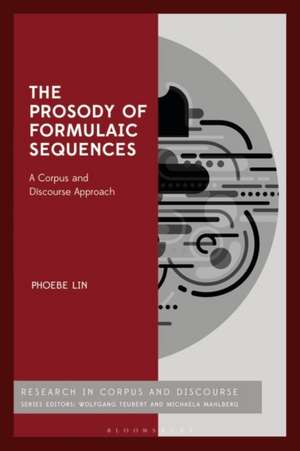The Prosody of Formulaic Sequences: A Corpus and Discourse Approach: Corpus and Discourse
Autor Dr Phoebe Linen Limba Engleză Paperback – 18 mar 2020
| Toate formatele și edițiile | Preț | Express |
|---|---|---|
| Paperback (1) | 224.29 lei 6-8 săpt. | |
| Bloomsbury Publishing – 18 mar 2020 | 224.29 lei 6-8 săpt. | |
| Hardback (1) | 773.39 lei 6-8 săpt. | |
| Bloomsbury Publishing – 19 sep 2018 | 773.39 lei 6-8 săpt. |
Din seria Corpus and Discourse
-
 Preț: 179.36 lei
Preț: 179.36 lei -
 Preț: 169.35 lei
Preț: 169.35 lei -
 Preț: 168.92 lei
Preț: 168.92 lei - 23%
 Preț: 197.86 lei
Preț: 197.86 lei - 13%
 Preț: 229.59 lei
Preț: 229.59 lei - 13%
 Preț: 257.50 lei
Preț: 257.50 lei - 22%
 Preț: 1064.84 lei
Preț: 1064.84 lei - 23%
 Preț: 199.03 lei
Preț: 199.03 lei - 18%
 Preț: 304.94 lei
Preț: 304.94 lei - 14%
 Preț: 1008.59 lei
Preț: 1008.59 lei - 13%
 Preț: 257.59 lei
Preț: 257.59 lei - 22%
 Preț: 258.24 lei
Preț: 258.24 lei - 22%
 Preț: 258.15 lei
Preț: 258.15 lei - 21%
 Preț: 218.91 lei
Preț: 218.91 lei - 30%
 Preț: 570.76 lei
Preț: 570.76 lei - 19%
 Preț: 495.61 lei
Preț: 495.61 lei - 11%
 Preț: 375.61 lei
Preț: 375.61 lei - 8%
 Preț: 299.86 lei
Preț: 299.86 lei - 19%
 Preț: 344.75 lei
Preț: 344.75 lei - 22%
 Preț: 257.68 lei
Preț: 257.68 lei - 13%
 Preț: 257.97 lei
Preț: 257.97 lei - 22%
 Preț: 258.42 lei
Preț: 258.42 lei - 22%
 Preț: 258.77 lei
Preț: 258.77 lei - 28%
 Preț: 374.34 lei
Preț: 374.34 lei - 14%
 Preț: 570.02 lei
Preț: 570.02 lei - 30%
 Preț: 569.13 lei
Preț: 569.13 lei - 22%
 Preț: 1125.24 lei
Preț: 1125.24 lei - 14%
 Preț: 298.74 lei
Preț: 298.74 lei - 22%
 Preț: 1008.01 lei
Preț: 1008.01 lei
Preț: 224.29 lei
Preț vechi: 288.65 lei
-22% Nou
Puncte Express: 336
Preț estimativ în valută:
42.93€ • 46.65$ • 36.09£
42.93€ • 46.65$ • 36.09£
Carte tipărită la comandă
Livrare economică 21 aprilie-05 mai
Preluare comenzi: 021 569.72.76
Specificații
ISBN-13: 9781350155305
ISBN-10: 1350155306
Pagini: 248
Dimensiuni: 156 x 234 mm
Greutate: 0.35 kg
Editura: Bloomsbury Publishing
Colecția Bloomsbury Academic
Seria Corpus and Discourse
Locul publicării:London, United Kingdom
ISBN-10: 1350155306
Pagini: 248
Dimensiuni: 156 x 234 mm
Greutate: 0.35 kg
Editura: Bloomsbury Publishing
Colecția Bloomsbury Academic
Seria Corpus and Discourse
Locul publicării:London, United Kingdom
Caracteristici
Innovative methodologies with which future researchers can explore phonological patterns of formulaic language
Notă biografică
Phoebe M. S. Lin is a Research Assistant Professor in the Department of English at the Hong Kong Polytechnic University, Hong Kong.
Cuprins
List of TablesList of FiguresAcknowledgements1. Introduction 2. Formulaic language: An overview 3. Can we identify formulaic language based on prosodic cues? 4. Study one: Do formulaic sequences align with intonation units? 5. Study two: A comprehensive profile of the intonation, stress and rhythm of formulaic language6. Study three: A multimodal approach to the identification of formulaic language by native speaker judgement 7. Conclusions: The prosody of formulaic language IndexBibliography
Recenzii
As one of the first studies to empirically test the hypothesis of distinct prosodic cues signalling formulaicity, Lin's exploration and careful description of various methods (e.g. automatic extraction, native speaker judgment) allow for an important evaluation of which methods are most appropriate and useful for identifying formulaic language ... Moreover, the level of detail with which Lin describes her method presents a useful research template that is easily transferable to other studies ... Provides a compelling contribution to the study of formulaicity and convincingly demonstrates the potential of prosodic cues for the identification of formulaic sequences.
In a linguistic research world dominated by the computer's love of the written word, we need a more methodical approach to the characterization and identification of formulaic language in speech. Phoebe Lin's very welcome book takes the reader through the complex process of empirically identifying contributory factors marking formulaicity in spoken language, and explores methods for improving its identification.
Phoebe Lin's study is a very welcome contribution to the field of applied linguistics. She extends the traditional study of FS as discrete structures and reveals the importance of their functions in different discourse environments. The book is packed with insights and is highly recommended for advanced students and researchers.
The volume is a valuable and timely addition to the existing literature on formulaic language. Although recent years have seen a lot of interest in this phenomenon, prosody has been largely overlooked. The three empirical studies that make up the volume shed important light on the prosody of formulaic language, highlighting its unique role in language learning and use, and providing a rich research agenda for future enquiry.
In a linguistic research world dominated by the computer's love of the written word, we need a more methodical approach to the characterization and identification of formulaic language in speech. Phoebe Lin's very welcome book takes the reader through the complex process of empirically identifying contributory factors marking formulaicity in spoken language, and explores methods for improving its identification.
Phoebe Lin's study is a very welcome contribution to the field of applied linguistics. She extends the traditional study of FS as discrete structures and reveals the importance of their functions in different discourse environments. The book is packed with insights and is highly recommended for advanced students and researchers.
The volume is a valuable and timely addition to the existing literature on formulaic language. Although recent years have seen a lot of interest in this phenomenon, prosody has been largely overlooked. The three empirical studies that make up the volume shed important light on the prosody of formulaic language, highlighting its unique role in language learning and use, and providing a rich research agenda for future enquiry.
